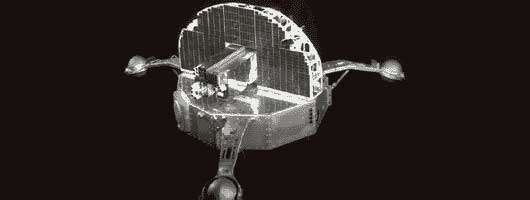OSO-3
Orbiting Solar Observatory-3

Mission Objectives
The major mission objectives of the third Orbiting Solar Observatory (NASA's mission S-57) were to measure electromagnetic radiation from the sun and from the celestial sphere in the ultraviolet, x-ray, and gamma-ray regions of the spectrum. In addition, the energy and spatial distributions of these emissions were to be determined. This was accomplished, under NASA/GSFC project direction, by the prime contractor, Ball Brothers Research Corporation, and by the experiment builders at Goddard Space Flight Center, Air Force Cambridge Research Labs, Ames Research Center, Massachusetts Institute of Technology, and the Universities of Michigan, Rochester, and California, San Diego.
The two oriented, or solar pointed, instruments were the GSFC X-ray Spectrometer and the AFCRL Ultraviolet Spectrometer. Five wheel instruments, that spin around viewing the sky and/or the sun, are the MIT Gamma Ray Telescope, the Rochester Particle and Gamma Ray Telescope, the UCSD X-ray Telescope, the Michigan Solar X-ray Detector, and the three AMES instruments: the Earth Albedo Telescopes, Emissivity Detectors, and Radiometer Telescopes.
The GSFC X-ray Spectrometer (W. Neupert, Principal Investigator) measured solar x-ray radiation in the wavelength range of 1 to 400 Angstroms, using a grazing incidence grating spectrometer with magnetic focusing photomultiplier scans of the spectral range 25--400 Angstroms in 6,144 steps. Two crystal goniometers scanned the spectral ranges of 1--2,5 and 2.5--6.4 Angstroms in 256 steps, while a third goniometer scanned the 6.4--25 Angstrom range in 512 steps. The X-ray Spectrometer also contained two parallel ion chambers sensitive to flare activity in the 2--8 Angstrom range.
The AFCRL Ultraviolet Spectrometer (H. E. Hinteregger, Principal Investigator) measured solar radiation in the 250--1300 Angstrom range, also using a grazing incidence grating spectrometer with magnetic focusing photomultiplier scans over the spectral range in 2040 discrete steps with two stepping rates.
The MIT Gamma Ray Telescope (G. Garmire Principal Investigator) detectred, identified, and determined the celestial distribution of gamma rays at 100 MeV or greater. It utilized a combination of NaI and CsI scintillators to convert the gamma ray into an electron/positron pair which then passed through plastic scintillators and Cerenkov counters into a lead sandwich absorber.
The Rochester Particle and Gamma Ray Telescope (M. Kaplon, Principal Investigator) studied charged particles of cosmic origin, using a directional Cerenkov detector. Coincidence and anticoincidence circuitry separated the charged partical signals from those of gamma rays.
The UCSD X-ray Telescope (L. Peterson, Principal Investigator) measured the intensity, energy, and directional properties of x-rays in the 7--190 keV energy range. A NaI scintillator with active collimation measured the energy of the incident x-rays.
The Michigan Solar X-ray Detector (R. Teske, Principal Investigator) measured the intensity of solar x-rays in the 8--14 Angstrom range. It used a nitrogen filled ion gauge that could discriminate between x-rays and high energy protons.
The AMES instruments (C. Neal, Principal Investigator) determined 1) the earth's reflectance using the Earth Albedo Telescopes, 2) measured the long term effects of radiation on selected surfaces using the Emissivity Detectors, and 3) measured the infrared radiation from earth in the 1-30 micron range. The Earth Albedo Telescope used six photomultipliers with filters in the ranges centered at 3200, 3700, 4500, 5600, 6800, and 7800 Angstroms. The Radiometer Telescopes used a parabolic mirrors and filters to provide a focal point monitored by a thermistor.
OSO-3 Information
Mission Objectives
Spacecraft
X-Ray Telescope
Scientific Results
Publications